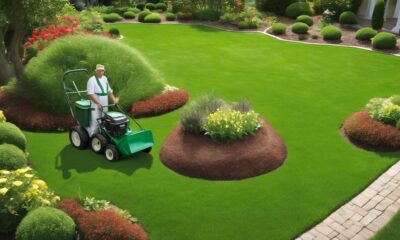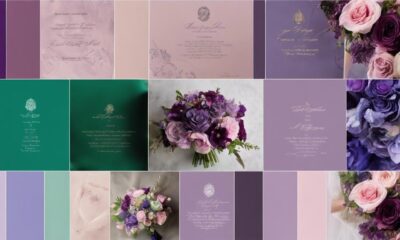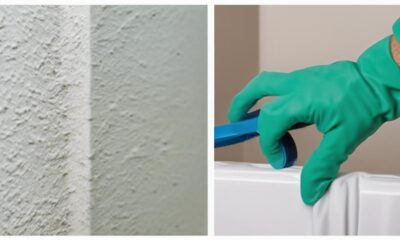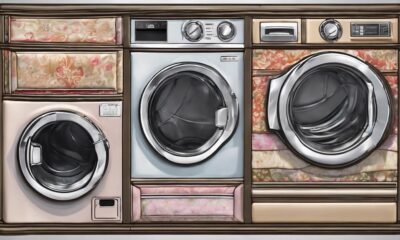Beginners Guides
Essential Humidifier Benefits for Your Home
2025
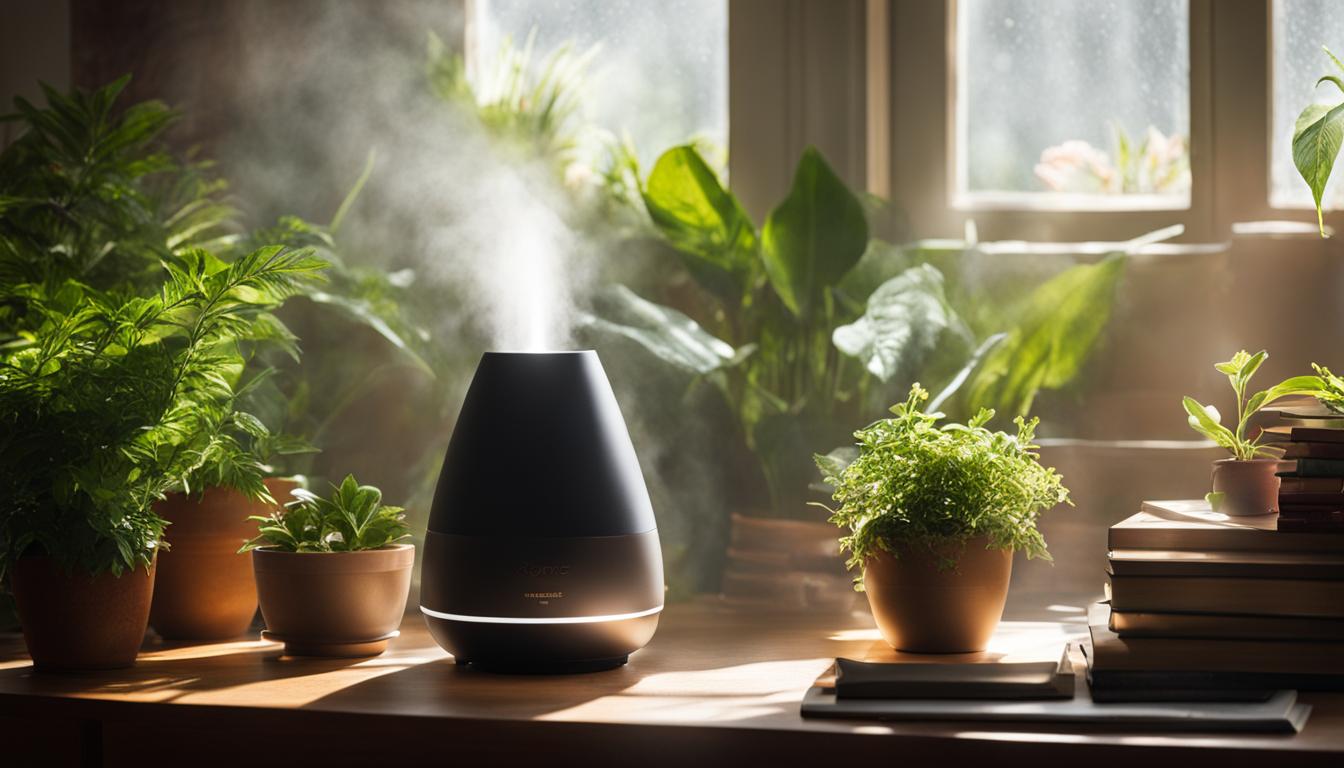
Welcome to our comprehensive guide on the benefits of using a humidifier in your home. Whether you’re looking to improve indoor air quality, alleviate allergies, maintain healthy skin, or simply enhance comfort, a humidifier can be a valuable addition to your living space.
Key Takeaways:
- Humidifiers help maintain indoor humidity levels.
- They come in two main types: evaporative and ultrasonic.
- Using a humidifier can improve indoor air quality.
- Humidifiers can provide relief from allergies and dry skin.
- They enhance overall comfort at home.
Now, let’s dive deeper into the details and explore the various benefits that a humidifier can offer for your home and well-being.
What is a Humidifier?
A humidifier is a freestanding appliance that helps maintain indoor humidity levels. It is commonly used in winter or in regions with low humidity. Low indoor humidity levels can lead to health problems such as nosebleeds, static electricity, and increased risk of respiratory infections. Humidifiers come in two main types: evaporative and ultrasonic.
Using Essential Oils with a Humidifier
Essential oils can be a wonderful addition to your humidifier, but it’s crucial to use them cautiously to ensure the best results. Different types of humidifiers, such as ultrasonic and evaporative humidifiers, can have varying effects when combined with essential oils.
Ultrasonic humidifiers, which utilize high-frequency vibrations to disperse water into the air, work exceptionally well with essential oils. The vibrations help break down the oils into smaller particles, facilitating their dispersion throughout the room. However, when it comes to evaporative humidifiers, caution should be exercised. These humidifiers pass the water through a filter, which can be damaged by the oils.
When using essential oils with a humidifier, it’s important to prioritize the use of high-quality, pure essential oils. Only a few drops are needed, as too much can be overwhelming. Keep in mind that essential oils are highly concentrated, so a little goes a long way.
The benefits of using essential oils with a humidifier are numerous. Not only do they add a delightful fragrance to the air, but they can also provide various health benefits. Some essential oils have purifying properties that can help cleanse the air, while others are known for their mood-boosting and relaxation-inducing effects. Additionally, certain oils, such as eucalyptus or peppermint, can provide respiratory support.
To summarize, using essential oils with a humidifier can be a wonderful way to enhance the ambiance of your home and enjoy the benefits of aromatherapy. Just remember to use them cautiously and select high-quality oils for the best results.
Best Essential Oils for Humidifiers
Enhance the benefits of your humidifier by incorporating the best essential oils to create a soothing and invigorating atmosphere in your home. These top essential oils are ideal for use with humidifiers:
- Lavender Oil: Known for its relaxation and sleep-promoting properties, lavender oil can help create a calming environment for a restful night’s sleep.
- Lemon Oil: With its refreshing and citrusy scent, lemon oil not only adds a pleasant fragrance but also acts as a natural air purifier that can eliminate odors and improve indoor air quality.
- Eucalyptus Oil: Recognized for its respiratory support, eucalyptus oil can help ease congestion and promote easier breathing, making it a great choice for those suffering from respiratory issues.
- Bergamot Oil: Boost your mood and reduce stress with the uplifting aroma of bergamot oil. This citrusy essential oil can help create a positive and energizing ambiance.
- Peppermint Oil: Offering a refreshing and invigorating scent, peppermint oil can provide a cooling effect and promote mental clarity, making it ideal for creating a stimulating environment.
By adding a few drops of these essential oils to your humidifier’s water tank, you can enjoy their therapeutic benefits throughout your home. Experiment with different combinations to create your desired atmosphere and experience the natural healing properties of these oils.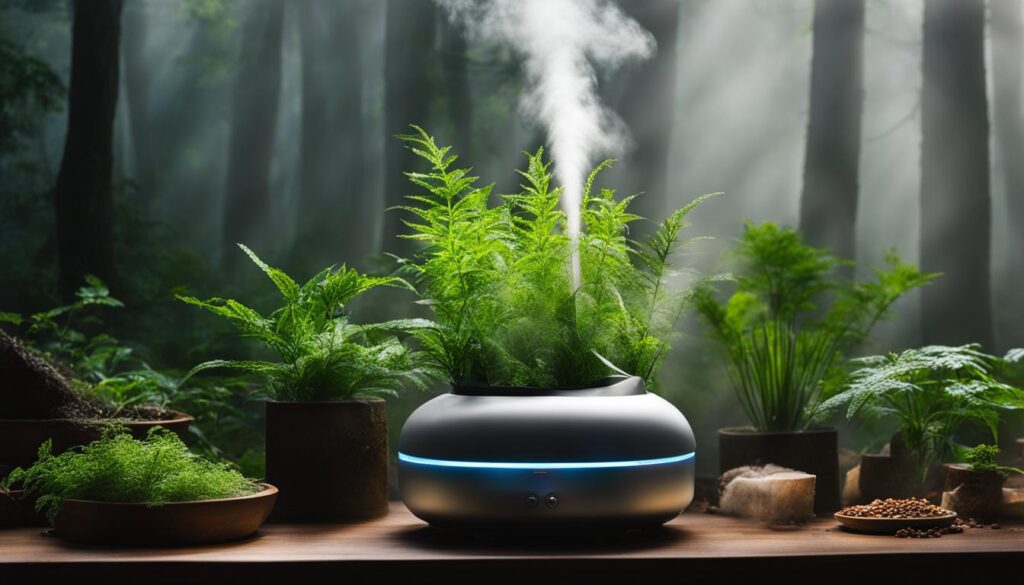
Benefits of Using Essential Oils with a Humidifier
When added to a humidifier, essential oils offer a range of benefits that can enhance your overall well-being. Let’s explore the numerous advantages of incorporating essential oils into your humidifying routine:
- Improved Air Quality: Essential oils have natural antimicrobial properties that can help remove impurities and allergens from the air, promoting a cleaner and healthier indoor environment.
- Relaxation: Certain essential oils, such as lavender and chamomile, are renowned for their calming effects. Adding these oils to your humidifier can create a soothing ambiance that promotes relaxation and relieves stress.
- Better Sleep: Essential oils like lavender and bergamot have sedative properties that can enhance sleep quality. Using these oils in a humidifier before bedtime can create a peaceful atmosphere conducive to a good night’s rest.
- Mood-Boosting: Aromatherapy has long been associated with mood enhancement. Essential oils like citrus (such as lemon) and peppermint have uplifting scents that can help improve mood and increase energy levels.
- Respiratory Support: Certain essential oils, such as eucalyptus and peppermint, have expectorant and decongestant properties that can help support respiratory health. When used in a humidifier, these oils can help alleviate symptoms of congestion and promote easier breathing.
By combining the benefits of essential oils with the moisture-providing capabilities of a humidifier, you can create a more pleasant and health-supportive indoor environment.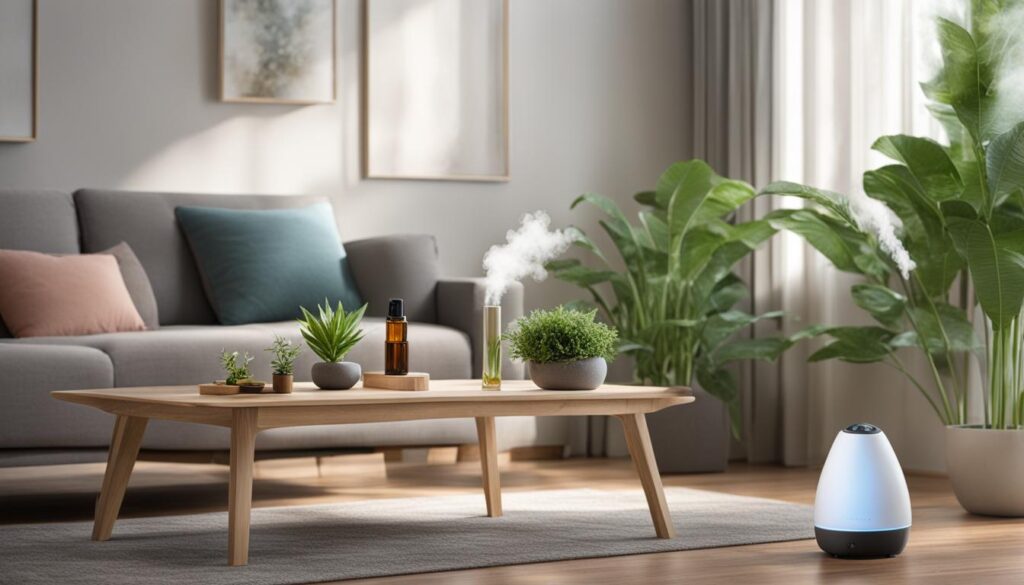
Different Types of Humidifiers
Humidifiers come in various types, each offering a unique way to add moisture to the air. Understanding the different types can help you choose the one that best suits your needs and preferences.
Here are the most common types of humidifiers:
Warm Mist Humidifiers
Warm mist humidifiers use a heating element to boil water, creating steam that is then released into the air. They can help alleviate respiratory symptoms and provide soothing relief during cold and flu season.
Cool Mist Humidifiers
Cool mist humidifiers disperse cool mist into the air without heating the water. They are ideal for households with children and pets, as they eliminate the risk of accidental burns.
Ultrasonic Humidifiers
Ultrasonic humidifiers use ultrasonic vibrations to break water down into tiny particles, releasing a fine mist into the air. They are virtually silent and highly energy-efficient.
Evaporative Humidifiers
Evaporative humidifiers work by blowing air through a wet wick, allowing water to evaporate and humidify the surrounding space. They are affordable and easy to maintain.
Vaporizers
Vaporizers produce warm steam by heating water and releasing it into the air. They are often used for medicinal purposes and can provide temporary relief from cold and flu symptoms.
Choosing the right type of humidifier depends on factors such as personal preferences, specific health needs, and the size of the area you want to humidify.
Now that we’ve explored the different types of humidifiers, let’s take a closer look at how to properly use them with essential oils.
Tips for Using a Humidifier with Essential Oils
When using a humidifier with essential oils, it is crucial to follow the manufacturer’s instructions to ensure proper usage. Using high-quality essential oils is also essential for the best results. Only a few drops of the oil should be added to the humidifier to avoid overwhelming the air with a strong scent.
In addition to using high-quality essential oils, regular cleaning and maintenance of the humidifier are necessary to prevent the buildup of bacteria and mold. Cleaning instructions provided by the manufacturer should be followed to maintain the optimal functioning of the humidifier.
By adhering to these tips, you can experience the many benefits of using a humidifier with essential oils. Improved air quality, relaxation, and respiratory support are just a few of the advantages that can enhance the overall quality of your indoor environment.
Properly using a humidifier with essential oils can make a significant difference in the air quality and overall ambiance of your home. The image above illustrates the harmonious combination of a humidifier and essential oils, creating a tranquil and comforting atmosphere.
Precautions and Risks of Using a Humidifier
While using a humidifier can provide numerous benefits, it’s important to be aware of certain precautions and risks associated with their use. By taking the necessary precautions and following proper maintenance guidelines, you can ensure a safe and healthy environment for you and your family.
Regular Cleaning is Essential
Dirty humidifiers can release dirty vapor into the air, which can potentially harm your indoor air quality. To prevent this, it is crucial to clean your humidifier regularly. Follow the manufacturer’s instructions on how to clean your specific model, or refer to the user manual. Cleaning the humidifier helps remove any mineral build-up, mold, or bacteria that may have accumulated over time.
Beware of Excessive Humidity
Although humidifiers are designed to add moisture to the air, excessive humidity can lead to its own set of problems. It can make breathing difficult, worsen allergy symptoms, and create an environment that promotes the growth of allergens like dust mites and mold.
To maintain a healthy indoor environment, it is recommended to keep the humidity levels between 30 and 50 percent. Monitoring the humidity levels with a hygrometer can help you ensure that it stays within a comfortable and safe range.
Use Purified Water
Water quality plays a crucial role in the effectiveness and safety of your humidifier. Using hard or tap water can lead to mineral buildup and the release of particles into the air. These particles can irritate the respiratory system and contribute to poor indoor air quality.
It is best to use purified or distilled water in your humidifier to minimize the risk of contamination. This will help prevent mineral deposits and ensure that only clean, pure water vapor is released into the air.
Consider Allergies and Respiratory Conditions
While a humidifier can provide relief for allergies and respiratory conditions, it is important to proceed with caution. People with existing allergies and respiratory conditions should consult with their healthcare provider before using a humidifier. Excessive humidity or improper maintenance can promote the growth of allergens, mold, and bacteria, which can exacerbate symptoms and potentially lead to respiratory infections.
By following these precautions and maintaining a clean and well-maintained humidifier, you can enjoy the benefits of improved indoor air quality and moisture without compromising your health.
Conclusion
In summary, incorporating a humidifier with essential oils into your home can bring about numerous benefits for your overall well-being. By using a humidifier, you can experience improved indoor air quality, which leads to a more comfortable and healthy living environment. The addition of essential oils enhances this experience, providing relaxation, better sleep, mood enhancement, and respiratory support.
To fully maximize these benefits, it is important to select the right type of humidifier for your needs and follow the manufacturer’s instructions. Additionally, using high-quality essential oils in moderation and maintaining proper cleaning and maintenance of your humidifier are crucial.
With these considerations in mind, a humidifier with essential oils can positively impact your quality of life. It contributes to a healthier indoor environment, promotes relaxation and well-being, and supports respiratory health. Invest in a humidifier today and enhance your overall comfort at home. Using a humidifier can greatly benefit the growth of hydrangeas. Hydrangeas thrive in a consistently moist environment, and adding a humidifier to their care routine can help maintain the necessary humidity levels. This simple addition can greatly improve the overall health and appearance of your hydrangeas. Follow these hydrangea care tips for best results. Using a humidifier in your home can improve indoor air quality, ease allergies, maintain healthy skin, and provide overall comfort. A humidifier is a freestanding appliance that helps maintain indoor humidity levels. It is important because low indoor humidity levels can lead to health problems such as nosebleeds, static electricity, and increased risk of respiratory infections. Yes, you can use essential oils with a humidifier. However, it is important to use them cautiously and follow the manufacturer’s instructions. Ultrasonic humidifiers work best with essential oils, while evaporative humidifiers may be damaged by the oils. Some of the best essential oils for humidifiers include lavender oil for relaxation and sleep, lemon oil for air purification, eucalyptus oil for respiratory support, bergamot oil for mood enhancement, and peppermint oil for a refreshing scent. Using essential oils with a humidifier can improve air quality, promote relaxation, enhance sleep quality, boost mood, and support respiratory health. Different types of humidifiers include warm mist humidifiers, cool mist humidifiers, ultrasonic humidifiers, evaporative humidifiers, and vaporizers. Each type uses different mechanisms to add moisture to the air. When using a humidifier with essential oils, it is important to follow the manufacturer’s instructions, use high-quality essential oils, and only add a few drops. Regular cleaning and maintenance of the humidifier is also crucial to prevent the buildup of bacteria and mold. Dirty humidifiers can release dirty vapor into the air, so regular cleaning is essential. Excessive humidity can make breathing difficult and worsen allergy symptoms. Using hard or tap water can lead to mineral buildup and the release of particles into the air. People with allergies and respiratory conditions should be cautious when using a humidifier, as it can promote the growth of dust mites and mold.How Can Using a Humidifier Benefit the Growth of Hydrangeas?
FAQ
What are the benefits of using a humidifier in your home?
What is a humidifier and why is it important?
Can I use essential oils with a humidifier?
What are the best essential oils for humidifiers?
What are the benefits of using essential oils with a humidifier?
What are the different types of humidifiers available?
What are some tips for using a humidifier with essential oils?
What precautions and risks should I be aware of when using a humidifier?
- About the Author
- Latest Posts
Meet Bethia, the visionary designer at ByRetreat who brings a touch of magic to every remote workspace she creates. With a boundless imagination and an eye for beauty, Bethia is passionate about transforming ordinary spaces into extraordinary havens of creativity and comfort.
Bethia possesses a unique talent for envisioning the perfect combination of furniture, colors, and textures that harmonize seamlessly in a room. She understands that selecting furniture goes beyond mere functionality; it’s about curating pieces that evoke a sense of style and sophistication while enhancing the overall ambiance.
Beginners Guides
The Best Time to Go on a Cruise for Perfect Weather
Sail through the maze of climate patterns to uncover the best times for perfect weather on a cruise, ensuring a memorable voyage awaits.

When it comes to choosing the best time to go on a cruise for perfect weather, it's like steering a maze of climate patterns to find that golden ticket. But fear not, as we have the compass to guide you in the right direction.
Understanding the seasonal nuances can make all the difference between a sun-kissed voyage and a rainy retreat. So, grab your sunscreen and pack your bags as we uncover the best times to set sail for idyllic weather conditions that will make your cruise a memorable experience.
Key Takeaways
- Caribbean cruises: December to mid-April for best weather conditions
- Alaskan cruises: Late June to mid-July for breathtaking landscapes
- Mediterranean cruises: April-May & September-October for ideal weather
- Hawaii cruises: Summer and fall months for dry weather and sunny skies
Ideal Months for Caribbean Cruises
For ideal weather conditions and a pleasant cruising experience in the Caribbean, consider booking your voyage between December and mid-April. During this period, the Caribbean boasts the best weather for cruises, with dry conditions and sunny skies prevailing. This stretch offers a fantastic opportunity to soak up the sun, enjoy water activities, and explore the stunning destinations in the region without the worry of rainstorms or excessive humidity.
Late summer into fall presents the cheapest time for Caribbean cruises, making it an excellent choice for budget-conscious travelers looking to experience the beauty of the Caribbean without breaking the bank. By opting for a cruise during this period, you can take advantage of lower prices and fewer crowds while still enjoying the warm waters and picturesque landscapes the Caribbean is known for.
Avoiding the peak season from December to April is advisable for those seeking a more peaceful and wallet-friendly experience. Sailing in late June through August allows travelers to steer clear of the crowds, particularly families on vacation during school breaks, making for a more relaxed and intimate cruise experience.
Optimal Weather for Alaskan Cruises

To maximize your Alaskan cruise experience, targeting late June through mid-July guarantees ideal weather conditions for enjoying the breathtaking landscapes and wildlife sightings in the region. During mid-July, you can witness the spectacular salmon run season, where various wildlife, including bears and bald eagles, gather along the rivers for this perfect phenomenon.
Late August to mid-September is another excellent window for Alaskan cruises, offering pleasant weather and often lower prices as it marks the end of the peak season. If your focus is on spotting whales, August is the prime time for your cruise, as these majestic creatures are commonly seen during this period.
For those seeking a balance between affordability and decent weather, mid-May to early June also presents a good opportunity to explore Alaska on a cruise. Keep these ideal weather periods in mind when planning your Alaskan adventure for an unforgettable experience.
Perfect Seasons for Mediterranean Cruises
April-May and September-October stand out as the prime seasons for Mediterranean cruises, offering ideal weather conditions and fewer crowds for a delightful experience exploring the region. During these shoulder seasons, the Mediterranean boasts milder temperatures and a more relaxed atmosphere compared to the peak tourist season in July and August. Traveling in April or May allows for pleasant sightseeing without the sweltering heat or overwhelming crowds. Likewise, September and October provide a serene setting for cruising with comfortable weather and less tourist congestion.
Additionally, prices for Mediterranean cruises tend to be lower from May to November, making it a cost-effective option for travelers seeking a budget-friendly voyage. Consider booking a Mediterranean cruise in May 2024 with MSC starting at $499/person to enjoy the perfect blend of favorable weather and affordable prices.
- Ideal weather conditions
- Fewer crowds
- Milder temperatures
- Lower prices during shoulder seasons
- Peak tourist season in July and August
Prime Time for Hawaii Cruises

The best time to start on a Hawaii voyage is usually during the summer and fall months when the weather is dry and the skies are sunny. Hawaii cruises are particularly rewarding from mid-September through October, offering ideal conditions for a memorable experience. If you're interested in whale watching, the period from late October through May is perfect for spotting these majestic creatures in their natural habitat. During this time, the weather remains pleasant, with minimal rainfall from August through October, ensuring a smooth sailing experience.
For travelers seeking a cost-effective option, January through March can be a good time to contemplate a Hawaii cruise, although weather conditions may vary slightly. These months often offer competitive pricing and fewer crowds, allowing you to enjoy the beauty of Hawaii at a more relaxed pace. Whether you're into adventure, relaxation, or simply soaking in the stunning scenery, a Hawaii cruise during the summer and fall months promises an unforgettable journey.
Best Weather for Australia & New Zealand Cruises
For those considering voyages beyond Hawaii, exploring the best weather for Australia & New Zealand cruises becomes paramount, especially as these regions offer unique experiences throughout the year. When planning your cruise to Australia and New Zealand, keep in mind the following key points for an enjoyable voyage:
- November to March: This period offers warm temperatures and sunny weather in major ports like Sydney, making it the best time to go on a cruise in Australia & New Zealand.
- Early February to mid-March: Experience the warmest weather in Australia during these months, ensuring a comfortable cruise.
- New Zealand's Climate: With a temperate climate, layering is recommended for cruises throughout the year to stay comfortable.
- Consider Off-Peak Months: October, November, or April can provide discounted fares in Australia outside the peak season, allowing for savings on your cruise.
- Reversed Seasons: Australia and New Zealand have reversed seasons compared to the northern hemisphere, influencing the ideal timing for a cruise in these regions.
Planning your trip around these factors will help you make the most of your cruise experience in Australia and New Zealand.
Conclusion
To guarantee the best time to go on a cruise for perfect weather is essential for a memorable and enjoyable experience. By researching the ideal months for different regions like the Caribbean, Alaska, Mediterranean, Hawaii, Australia, and New Zealand, you can secure smooth sailing and sunny skies.
Don't just take our word for it, investigate the truth of this theory yourself and discover the magic of cruising in ideal weather conditions.
- About the Author
- Latest Posts
Introducing Ron, the home decor aficionado at ByRetreat, whose passion for creating beautiful and inviting spaces is at the heart of his work. With his deep knowledge of home decor and his innate sense of style, Ron brings a wealth of expertise and a keen eye for detail to the ByRetreat team.
Ron’s love for home decor goes beyond aesthetics; he understands that our surroundings play a significant role in our overall well-being and productivity. With this in mind, Ron is dedicated to transforming remote workspaces into havens of comfort, functionality, and beauty.
Beginners Guides
The Best Time to Cruise for Budget-Friendly Deals
Fulfill your wanderlust dreams without draining your wallet by learning the key to scoring budget-friendly cruise deals.

When it comes to finding budget-friendly cruise deals, timing is key. Imagine setting sail on the crystal blue waters of the Caribbean or exploring the stunning glaciers of Alaska without breaking the bank.
There's a specific window of opportunity that savvy cruisers keep an eye on to secure the best rates and save some serious cash. But how do you know when to book your next adventure to make the most of your budget?
Let's uncover the secrets behind scoring the ultimate cruise deals and making your dream vacation a reality.
Key Takeaways
- Booking during wave season in January to March ensures budget-friendly deals.
- Monitoring prices post-booking for drops leads to potential refunds or upgrades.
- Repositioning cruises in spring and fall offer cost-effective options.
- Leveraging loyalty programs maximizes savings for affordable cruising.
Ideal Seasons for Budget-Friendly Cruises
When seeking budget-friendly cruise deals, timing plays an important role in securing the best value for your money. Shoulder seasons such as September, October, and early December present excellent opportunities for travelers looking for cheaper fares. These off-peak times often offer discounted rates and fewer crowds, making it an ideal choice for budget-conscious individuals.
Additionally, booking during wave season in January and February can lead to significant discounts and promotions, maximizing savings on your cruise vacation.
Repositioning cruises during spring and fall are another fantastic option for savvy travelers seeking affordable deals. These cruises often provide cost-effective choices as cruise lines move their ships between different regions.
Avoiding major holidays and school breaks is also key to securing cheaper cruise fares and ensuring a more relaxed cruising experience. Moreover, sailing from Florida during off-peak times can offer a wide range of options and better deals for those looking to save on their cruise adventures.
Strategies for Booking Affordable Cruises

To secure the best deals on cruises, it's important to employ strategic booking approaches that maximize cost savings and value for your vacation. When aiming for budget-friendly cruise deals, consider the following strategies:
- Booking in Advance: Securing your cruise early, especially during wave season from January to March, can lead to lower rates and additional benefits.
- Monitoring Fare Changes: Keep an eye on fluctuating fares and be ready to book when prices drop to secure the best deal.
- Being Flexible with Travel Dates: Flexibility can be key in finding affordable cruise options, as adjusting your travel dates slightly can result in significant savings.
- Considering Repositioning Cruises: Exploring repositioning cruises or sailing during shoulder seasons can offer unique routes and discounted prices.
- Utilizing Loyalty Programs and Off-Peak Times: Take advantage of loyalty programs, monitor price drops, and consider traveling during off-peak times to maximize your savings on cruise vacations.
Best Times to Score Cruise Deals
During wave season from January to March, travelers can capitalize on the best times to secure budget-friendly cruise deals. Booking well in advance is key to snagging the most favorable timing and rates for your cruise.
Additionally, considering repositioning cruises during the spring and fall can offer discounted prices, making them a great option for those seeking budget-friendly deals. It's also advisable to keep an eye out for price drops even after booking, as this could potentially lead to refunds or upgrades for your cruise experience.
Leveraging loyalty programs or memberships can grant you access to exclusive discounts and savings on your upcoming cruise. By being proactive and strategic in your approach to booking and monitoring deals, you can maximize your chances of finding the best cruise deals that align with your budget and preferences.
Timing Tips for Budget-Friendly Cruises

Let's explore practical strategies for maximizing your savings on budget-friendly cruises through strategic timing tips. When aiming to secure the best cruise deals that align with your budget, consider the following insights:
- Booking in Advance: Take advantage of wave season from January to March to lock in lower rates and secure desirable cabin options.
- Monitoring Prices: Keep an eye on price drops even after booking to potentially benefit from refunds or upgrades, enhancing your overall cruise experience.
- Loyalty Programs: Utilize loyalty programs or memberships to access additional discounts and exclusive perks, making your budget-friendly cruise even more cost-effective.
- Nearby Ports: Opt for cruises departing from nearby ports to save on airfare costs, enabling you to allocate more of your budget towards onboard activities and excursions.
- Discounts Galore: Embrace the array of discounts available during wave season and beyond, ensuring that you snag the best possible deal for your budget-friendly cruise adventure.
When to Book for Cruise Savings
Securing cruise savings hinges on strategic timing and proactive booking practices. To find the best deals, consider booking during wave season from January to March when many cruise lines offer enticing discounts.
Booking early not only guarantees better rates but also provides a wider selection of cabin choices. Keep an eye out for fare changes even after booking, as price drops may occur, presenting an opportunity for additional savings.
While waiting for last-minute deals can sometimes lead to the cheapest rates, this approach often comes with limited cabin availability. To stay informed about price fluctuations, utilize tools like the Shipmate app and Cruise Critic for efficient monitoring.
Conclusion
To summarize, cruising during the off-peak season can help us save some serious dough. Booking early during wave season is key to scoring those sweet deals.
So, let's set sail and make some memories without breaking the bank. Remember, early bird gets the worm – or should I say, the cruise discount!
- About the Author
- Latest Posts
Introducing Ron, the home decor aficionado at ByRetreat, whose passion for creating beautiful and inviting spaces is at the heart of his work. With his deep knowledge of home decor and his innate sense of style, Ron brings a wealth of expertise and a keen eye for detail to the ByRetreat team.
Ron’s love for home decor goes beyond aesthetics; he understands that our surroundings play a significant role in our overall well-being and productivity. With this in mind, Ron is dedicated to transforming remote workspaces into havens of comfort, functionality, and beauty.
Beginners Guides
Best Time to Go on an Alaskan Cruise for Wildlife Watching
Get ready to discover the optimal time for wildlife enthusiasts to embark on an Alaskan cruise – the ultimate season for extraordinary encounters awaits!

One could contend that any time of year is fitting for an Alaskan cruise, but if you genuinely want to maximize your wildlife watching opportunities, timing is key.
While many months offer glimpses of nature's wonders, there is a particular period that stands out above the rest.
Join us as we explore the intricacies of the Alaskan wilderness and uncover the secrets of when to set sail on a journey that promises unforgettable encounters with some of the most magnificent creatures on earth.
Key Takeaways
- Prime months for wildlife viewing in Alaska are May, June, and September.
- Peak whale watching season is from mid-June to August.
- Best time for bear spotting is between July and early September.
- Ideal months for bald eagle sightings in southeast Alaska are from May to September.
Prime Months for Wildlife Viewing
During the prime months of May, June, and September, Alaska offers the best conditions for wildlife enthusiasts to observe a diverse array of animals in their natural habitats. June marks the beginning of summer, a time when the landscape comes alive with the sights and sounds of wildlife.
July and August are ideal for witnessing brown bears fishing for salmon and catching glimpses of majestic moose roaming through the wilderness. These months provide ample opportunities for up-close wildlife viewing experiences, especially during the salmon run when bears gather along the rivers to feast.
As the summer changes into September, visitors can look forward to spotting humpback whales during their annual migration, as well as witnessing the spectacular spawning salmon and caribou herds moving across the land. The shoulder seasons offer a unique chance to explore Alaska inside and out, with fewer crowds and mosquitoes, making it an ideal time for wildlife enthusiasts to immerse themselves in the natural beauty of the region.
Peak Whale Watching Season

In the peak whale watching season in Alaska, which typically spans from mid-June to August, enthusiasts have the best opportunities to witness humpback whales and other species in their natural habitat. Humpback whales are commonly sighted during the summer months as they feed on small fish and krill.
Killer whales, also known as orcas, are best spotted in May and June near Ketchikan, Juneau, and Seward, hunting for seals and other marine mammals. Grey whales migrate to southern Alaska in late spring, showcasing their impressive breaching behaviors.
Blue whales, the largest animals on Earth, may be seen in July and August, traveling through Alaskan waters in search of food. Whale sightings can vary depending on the specific month of your Alaskan cruise, so choosing the right time within the peak season is important for maximizing wildlife watching opportunities while sailing through these majestic waters.
Best Time for Bear Spotting
Ideally situated between July and early September, the peak time for bear spotting in Alaska coincides with the salmon influx that attracts these magnificent creatures to the creeks and streams of the region. During this period, Grizzly bears can be observed in their natural habitat, offering a thrilling experience for wildlife enthusiasts. Royal Caribbean Cruise Tours in Alaska often include bear viewing excursions, enhancing the opportunity to witness these powerful animals up close. For best bear sightings, consider visiting during the salmon run in July, a time when bears are actively hunting for fish in creeks and streams, particularly in locations like Ketchikan. Alaska's diverse landscapes and ecosystems provide ample opportunities for bear viewing, from observing black bears to encountering majestic brown bears. Whether through guided tours or remote float plane trips, Alaska offers a range of experiences to witness these iconic creatures in their element.
| Best Time for Bear Spotting | |
|---|---|
| July | Salmon run |
| Early September | Grizzly bears |
| Creeks | Streams |
| Ketchikan | Royal Caribbean Cruise Tours |
Ideal Months for Eagle Sightings

The peak months for perfect bald eagle sightings in southeast Alaska are from May to September. During these months, as part of an Alaska cruise, birdwatching enthusiasts can witness the majestic bald eagles in their natural habitat. Southeast Alaska, home to around 30,000 bald eagles, offers ample opportunities for wildlife watching, especially near bodies of water where eagles are commonly spotted.
The Sitka Cultural Discovery excursion is a great way to observe bald eagles up close, as they're frequently seen near streams and bodies of water. With approximately 470 bird species in the region, including the iconic bald eagle, Southeast Alaska provides a diverse birdwatching experience for nature lovers.
Whether soaring through the skies or perched on branches overlooking the water, bald eagles are a common sight throughout the summer months in this pristine Alaskan wilderness. For those seeking unforgettable eagle sightings and a chance to immerse themselves in Alaska's rich wildlife, visiting during the peak months offers an unparalleled birdwatching experience.
Optimal Time for Otter Encounters
Best timing for observing otters in Alaska ranges from early spring through the end of July. During this period, the chances of encountering these enchanting creatures are at their peak. Here are some key points to keep in mind for prime otter encounters during your Alaskan cruise:
- Steller sea lions: While otters are more prevalent during spring and early summer, Steller sea lions can be spotted year-round in Alaska. Keep an eye out for these majestic marine mammals as they often share habitats with otters.
- Streams and creeks: Otters are frequently seen near streams and creeks, making these areas prime locations for wildlife watching. Cruise along these waterways to increase your chances of a memorable otter sighting.
- Wildlife tours: Participating in wildlife tours in Alaska can enhance your otter encounters. These tours often provide opportunities to get up close to Steller sea lions, with otters sometimes making surprise appearances alongside them.
- Sea otters near the ocean: Whether near the ocean or inland water bodies, otters are adaptable creatures that thrive in various environments. Keep a lookout for these playful animals during your Alaskan cruise for a truly immersive wildlife experience.
Conclusion
To sum up, our investigation confirms that the best time to go on an Alaskan cruise for wildlife watching is indeed during the peak season of July.
The abundance of wildlife sightings, perfect weather conditions, and increased chances of spotting bears, whales, eagles, otters, and other fascinating creatures make July the ideal month for an unforgettable Alaskan wildlife experience.
Don't miss out on this prime opportunity to witness the wonders of nature in their natural habitat.
- About the Author
- Latest Posts
Introducing Ron, the home decor aficionado at ByRetreat, whose passion for creating beautiful and inviting spaces is at the heart of his work. With his deep knowledge of home decor and his innate sense of style, Ron brings a wealth of expertise and a keen eye for detail to the ByRetreat team.
Ron’s love for home decor goes beyond aesthetics; he understands that our surroundings play a significant role in our overall well-being and productivity. With this in mind, Ron is dedicated to transforming remote workspaces into havens of comfort, functionality, and beauty.
-

 Decor5 days ago
Decor5 days agoMaximalist Decor Explained: Embrace More Style
-

 Vetted4 weeks ago
Vetted4 weeks ago15 Best Drip Irrigation Systems to Keep Your Garden Thriving
-

 Vetted1 week ago
Vetted1 week ago15 Best Foot Massagers for Neuropathy to Soothe Your Feet and Relieve Discomfort
-

 Vetted2 weeks ago
Vetted2 weeks ago15 Best Sports Laundry Detergents for Keeping Your Activewear Fresh and Clean
-
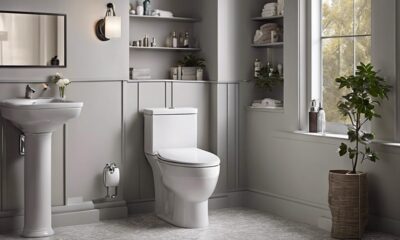
 Vetted3 weeks ago
Vetted3 weeks ago15 Best Tall Toilets for Seniors That Combine Comfort and Safety
-
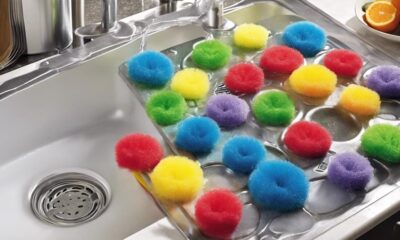
 Vetted3 weeks ago
Vetted3 weeks ago15 Best Dish Scrubbers to Keep Your Kitchen Sparkling Clean
-
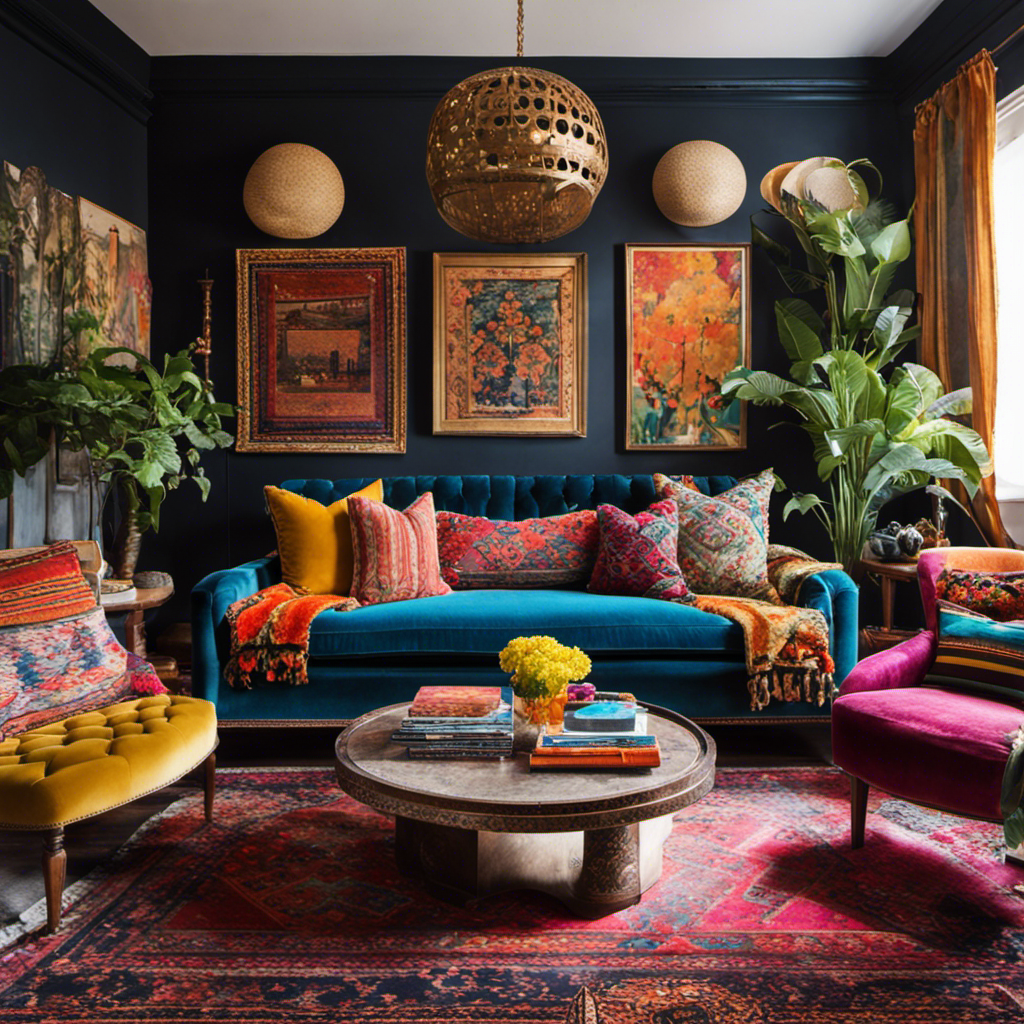
 Decor3 weeks ago
Decor3 weeks agoWhat Is Eclectic Home Decor
-

 Vetted2 days ago
Vetted2 days ago15 Best Organic Pest Control Solutions for a Naturally Pest-Free Home







